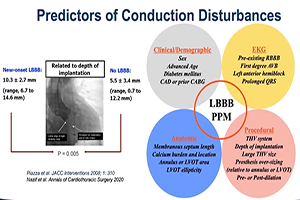The incidence and impact of cardiac conduction disturbances after transcatheter aortic valve replacement
Abstract
Transcatheter aortic valve replacement (TAVR) has developed into an established therapy for patients with severe aortic stenosis (AS) across the spectrum of surgical risk. Despite improvements in transcatheter heart valve (THV) technologies and procedural techniques, cardiac conduction disturbances, including high degree atrioventricular block (AVB) requiring permanent pacemaker (PPM) implantation and new-onset left bundle branch block (LBBB), remain frequent complications. TAVR-related conduction disturbances occur due to injury to the conduction system from interactions with interventional equipment and the transcatheter valve stent frame. Risk factors for post-TAVR conduction disturbances have been identified and include clinical characteristics, baseline electrocardiogram findings (right bundle branch block), anatomic factors, and potentially modifiable procedural factors (type of transcatheter valve, depth of implantation, over-sizing). New-onset LBBB and PPM implantation after TAVR have been shown to be associated with adverse long-term clinical outcomes, including mortality and heart failure hospitalization. These clinical consequences are likely to be of increasing importance as TAVR is utilized in younger and lower risk population. This review provides an updated overview of the literature regarding the incidence, predictors, and clinical outcomes of TAVR-related conduction disturbances, as well as proposed strategies for the management of this frequent clinical challenge.
Cover






